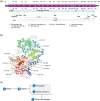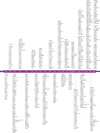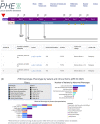Novel PHEX gene locus-specific database: Comprehensive characterization of vast number of variants associated with X-linked hypophosphatemia (XLH)
- PMID: 34806794
- PMCID: PMC9299612
- DOI: 10.1002/humu.24296
Novel PHEX gene locus-specific database: Comprehensive characterization of vast number of variants associated with X-linked hypophosphatemia (XLH)
Abstract
X-linked hypophosphatemia (XLH), the most common form of hereditary hypophosphatemia, is caused by disrupting variants in the PHEX gene, located on the X chromosome. XLH is inherited in an X-linked pattern with complete penetrance observed for both males and females. Patients experience lifelong symptoms resulting from chronic hypophosphatemia, including impaired bone mineralization, skeletal deformities, growth retardation, and diminished quality of life. This chronic condition requires life-long management with disease-specific therapies, which can improve patient outcomes especially when initiated early in life. To centralize and disseminate PHEX variant information, we have established a new PHEX gene locus-specific database, PHEX LSDB. As of April 30, 2021, 870 unique PHEX variants, compiled from an older database of PHEX variants, a comprehensive literature search, a sponsored genetic testing program, and XLH clinical trials, are represented in the PHEX LSDB. This resource is publicly available on an interactive, searchable website (https://www.rarediseasegenes.com/), which includes a table of variants and associated data, graphical/tabular outputs of genotype-phenotype analyses, and an online submission form for reporting new PHEX variants. The database will be updated regularly with new variants submitted on the website, identified in the published literature, or shared from genetic testing programs.
Keywords: Phosphate regulating gene with Homology to Endopeptidases that maps to the X chromosome (PHEX); X-linked hypophosphatemia (XLH); fibroblast growth factor 23 (FGF23); locus-specific database; osteomalacia; rickets.
© 2021 The Authors. Human Mutation published by Wiley Periodicals LLC.
Conflict of interest statement
This study was sponsored and funded by Ultragenyx Pharmaceutical Inc. (Ultragenyx) in partnership with Kyowa Kirin International. Y. Sabbagh is an employee of Inozyme Pharma. S. Daugherty, N. Miller, S. Krolczyk and P. Ramesan are employees and shareholders of Ultragenyx. S. Sarafrazi, P. Boada and S. Eisenbeis are former employees of Ultragenyx and S. Eisenbeis is also a shareholder. K. Dill is a 3rd party contractor for Ultragenyx. B. Johnson and R. Truty are employees and shareholders of Invitae Corporation. L. Chunn and M. J. Kiel are employees of Genomenon Inc. T. O. Carpenter and E. A. Imel have received research funding from Ultragenyx. M. J. Econs has received consultant fees from Ultragenyx and holds a patent that is licensed to Ultragenyx.
Figures





References
-
- Albright, F. , Butler, A. M. , & Bloomberg, E. (1937). Rickets resistant to vitamin D therapy. American Journal of Diseases of Children, 54(3), 529–547. 10.1001/archpedi.1937.01980030073005 - DOI
-
- Barros, N. M. , Hoac, B. , Neves, R. L. , Addison, W. N. , Assis, D. M. , Murshed, M. , Carmona, A. K. , & McKee, M. D. (2013). Proteolytic processing of osteopontin by PHEX and accumulation of osteopontin fragments in Hyp mouse bone, the murine model of X‐linked hypophosphatemia. Journal of Bone and Mineral Research, 28(3), 688–699. 10.1002/jbmr.1766 - DOI - PubMed
-
- Beck‐Nielsen, S. S. , Brock‐Jacobsen, B. , Gram, J. , Brixen, K. , & Jensen, T. K. (2009). Incidence and prevalence of nutritional and hereditary rickets in southern Denmark. European Journal of Endocrinology/European Federation of Endocrine Societies, 160(3), 491–497. 10.1530/eje-08-0818 - DOI - PubMed
-
- Beck‐Nielsen, S. S. , Brusgaard, K. , Rasmussen, L. M. , Brixen, K. , Brock‐Jacobsen, B. , Poulsen, M. R. , Vestergaard, P. , Ralston, S. H. , Albagha, O. M. , Poulsen, S. , Haubek, D. , Gjørup, H. , Hintze, H. , Andersen, M. G. , Heickendorff, L. , Hjelmborg, J. , & Gram, J. (2010). Phenotype presentation of hypophosphatemic rickets in adults. Calcified Tissue International, 87(2), 108–119. 10.1007/s00223-010-9373-0 - DOI - PubMed
-
- Beck‐Nielsen, S. S. , Mughal, Z. , Haffner, D. , Nilsson, O. , Levtchenko, E. , Ariceta, G. , de Lucas Collantes, C. , Schnabel, D. , Jandhyala, R. , & Mäkitie, O. (2019). FGF23 and its role in X‐linked hypophosphatemia‐related morbidity. Orphanet Journal of Rare Diseases, 14(1), 58. 10.1186/s13023-019-1014-8 - DOI - PMC - PubMed
Publication types
MeSH terms
Substances
LinkOut - more resources
Full Text Sources
Research Materials
Miscellaneous

